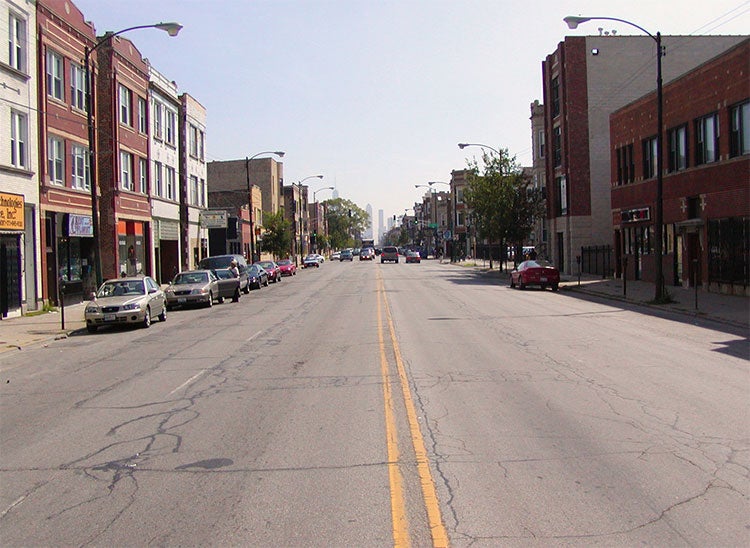
Experts Talk: Implications of AV/CVs on City Development with Justin Robbins
Experts Talk is an interview series with technical leaders from across our transportation program.
Autonomous and Connected Vehicles Will Fundamentally Change How We Plan Cities and Build Infrastructure
Advances in transportation technology will undoubtedly change how we move around our cities and towns. But what many people fail to realize, is how these same advances can have huge consequences for how we organize and build our cities. Driven by this technology, our generation has a once in a lifetime opportunity to fundamentally reshape the way our cities function, and we have a chance to address the mistakes of the past while defining a new vision for the future that ensures a high quality of life, equitable mobility, and a more sustainable way to live.

Emerging technologies, such as AV/CV adoption, can maximize land use and minimize long-term maintenance costs due to high-density development. Justin Robbins, AICP, serves as an AV/CV Transportation Planner in our Advanced Technologies for Surface Transportation practice. Recently he put his theories into practice on an HDR project for downtown Lincoln, Nebraska, where he helped design the framework for a pilot deployment of autonomous microshuttles within a mixed traffic, revenue-generating system. Justin is also an adjunct faculty member at his alma mater, The Ohio State University, and teaches a graduate level class on urban design.
Implications of AV/CVs on City Development
Q. Before delving into the topic of autonomous vehicles and connected vehicles, could you share your perspective on the relationship between transportation and our built environment?
A. It’s hard to overstate the connection between transportation and land use within our built environment. This is very apparent when you start looking at older cities’ transportation networks and see how they change over time due to the various travel modes available. One of my favorite examples is in Lyon, France, where you have the remains of a Roman settlement on one edge of the city, which leads to a Medieval district, then a Renaissance district, and then into the modern developed area. Each era had certain types of transportation which determined streets’ organization and size, building sites, and the density of development.
Here in the United States, it’s interesting to compare today's standard, auto-oriented development pattern to what we built up until 70 years ago; it’s vastly different. Up until the car became our chief mode of travel, we had never built this way before. You can see American cities start to grow beyond their historic cores, which usually are organized as a grid. You see how the development changes and spreads outward geographically over time, exploding in area after the 1950s.
Over the past decade, city planning experts have recognized that the balance between land value and transportation costs is skewed. Our current model requires a large amount of land along with substantial amounts of infrastructure to allow access to development. This ties in with the problem of parking. It’s helpful to understand how parking affects — and impedes — development density.
For example, let’s take a typical retail building developed around automobile transportation. A large-format retail store could have an area of approximately 75,000 square feet. Let’s assume a common requirement of one parking space per 300 square feet of retail space. The building then would need at least 250 parking spaces or approximately 109,000 square feet land devoted to parking! Development that is surface parking, both in suburban and urban settings, uses from 40 to 60 percent of the total land area for parking, while only 10 to 25 percent is usable building floor area. Eliminating parking spaces could free up massive amounts of land for additional development or more green space, for example.

The need for parking not only drives our ever-expanding development pattern further away from the city center, but also makes it difficult to build densely. In short, more parking requires more land, which requires more infrastructure (roadways, water, storm, sanitary and natural gas). It costs a lot of money in public infrastructure and private land to develop around the automobile, yet we don’t get nearly as much return on value from the land use it serves. As our aging infrastructure nears the end of its useful life, the financial burden of its maintenance and replacement costs will start to hit cities and regions hard.
Q. When you speak about autonomous transportation, what do you mean by that, and how is it any different than our current human-driven system?
A. I want people to discard the idea that autonomous transportation is a slightly different version of today’s car. Yes, people will be able to buy an individual autonomous vehicle , but the exciting possibilities lie beyond that model. Imagine having fleets of AVs which can move people throughout an area much quicker, safer and cheaper than our current model. In essence, it would be a taxi system that operates with AVs requested via smartphone to pick you up and drop you off door-to-door, and this could eliminate the need for parking in many areas. This type of transportation could exist in various forms; and the AVs’ look, feel, function, shape, capacity and role could drastically change also.
Sprawling development is the result of our current automobile system. While AVs do not require us to build differently, they allow us to build differently.
Q. Beyond changing the way we get around, how could AV/CVs redefine the landscapes of our cities?
A. Most people fear the word “density” -- but density is what really defines a place. Typically, density results in areas built for pedestrian walkability and scaled around people. Compare the experience of walking in a historic downtown versus an auto-oriented suburb, and most people will choose the downtown. By incorporating AV/CV technology into all forms of passenger transportation (car, bus, train, etc.), we can build this way again, without limiting development or devoting huge sums of money to underused land, overbuilt infrastructure or expensive parking areas. Our land-development value and infrastructure costs could achieve better parity. In light of the housing shortages and affordability issues around our country, reduced costs would greatly benefit the communities we serve.
Q. We see the public sector testing and planning for an AV/CV future, but what should they consider in order to integrate these new vehicles within the built environment? How could AV/CV adoption affect issues like zoning, parking regulations, transportation taxes, etc.?
A. Much of the longstanding framework that cities have in place to guide infrastructure and development will need to be reexamined. It doesn’t make sense to impose parking requirements through zoning regulations if our transportation system no longer requires parking. Zoning codes typically have been written in the age of the privately-owned automobile, and regulations such as density maximums, building spacing and required yard space were all written to create a certain type of auto-focused development pattern. That may no longer be the case, and these requirements should be re-thought.
AV/CV technology will affect even things like revenue and funding. Existing revenue streams such as traffic violations, parking violations and parking fees could all be undercut. But the new technologies do offer the option to charge proportionally for using public roadways and also to charge for congestion. So there are ways that communities can recapture some of the lost revenue and funding that might take place.
Q. How should urban planners and government leadership best prepare for AV/CVs as they begin operating in our communities?
A. Technology’s impacts will be huge, and understanding their full magnitude will take place over a period of decades. Removing the human driver from a vehicle opens up a new realm of possibilities and a world of disruption. Our entire development and infrastructure system built over the past 70 years centered around a specific transportation model that’s about to radically change, and the entire world we built around that model will change with it. Land use, development density and infrastructure changes are just a start. Three years ago, a planner would have been laughed out of a meeting to suggest planning for the technology, but that’s changing. More people realize this is coming -- along with a major opportunity to remake our cities in ways that benefit people.
The key is strategic planning and developing a technology roadmap. This can help urban planners and government leaders identify current, mid-term and long-range actions that will enable them to be ready for the next big innovation.
Inspiration & Advice: Justin Robbins
Q. What inspired you to focus your career on developing transportation initiatives using cutting-edge AV/CV technologies?
A. I truly believe that what we as a society build today should benefit the generations to come. As it stands in many parts of the United States, the strip mall and auto-oriented corridor will be our legacy. I think we can do better, and the coming technologies will give us a way to do it. It’s an exciting time to be a planner. The positive steps we take today could affect the livability and success of American cities for generations to come.
Q. What advice would you offer to new professionals in surface transportation industries who will be applying these emerging technologies out in the field?
A. Keep an eye on the greater context, not just the problems at hand. Understand how technologies can disrupt any number of existing systems. These technologies will not only affect transportation, but also will potentially rewrite the fortunes of entire regions.
Each Experts Talk interview illuminates a different aspect of transportation infrastructure planning, design and delivery. Check back regularly for new insights from the specialized experts and thought leaders behind our award-winning, full service consulting practice.


